Management: Development of Regional Division and Self-Managed Teams
VerifiedAdded on 2023/03/30
|17
|3177
|209
AI Summary
The report focuses on the development of Regional division of OzAlpha and the use of self-managed teams for creativity and innovation. It discusses the advantages and disadvantages of virtual teams and self-managed teams, and recommends a democratic leadership style. It also covers planning, organizing, leading, and controlling within the organization.
Contribute Materials
Your contribution can guide someone’s learning journey. Share your
documents today.
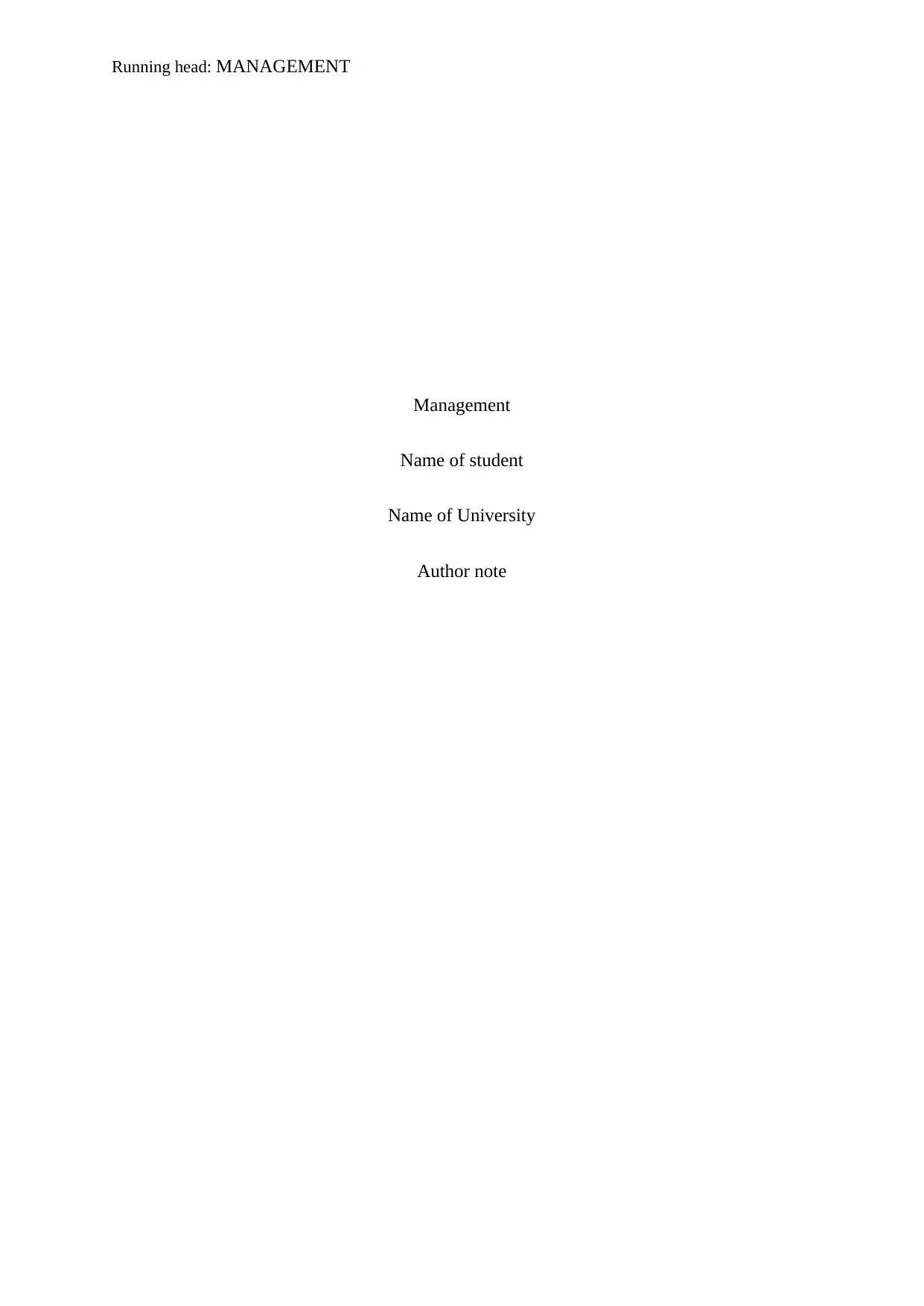
Running head: MANAGEMENT
Management
Name of student
Name of University
Author note
Management
Name of student
Name of University
Author note
Secure Best Marks with AI Grader
Need help grading? Try our AI Grader for instant feedback on your assignments.
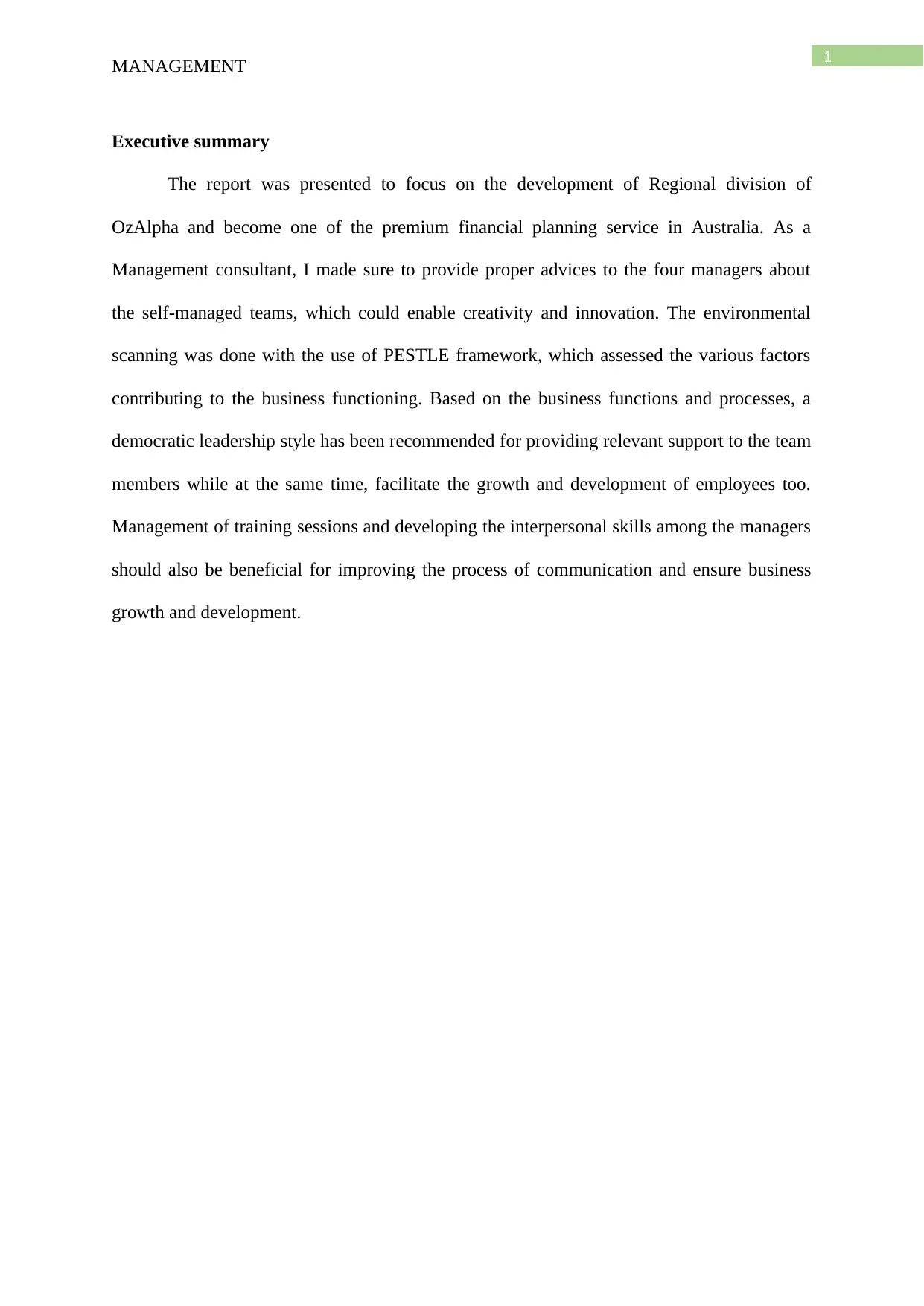
1
MANAGEMENT
Executive summary
The report was presented to focus on the development of Regional division of
OzAlpha and become one of the premium financial planning service in Australia. As a
Management consultant, I made sure to provide proper advices to the four managers about
the self-managed teams, which could enable creativity and innovation. The environmental
scanning was done with the use of PESTLE framework, which assessed the various factors
contributing to the business functioning. Based on the business functions and processes, a
democratic leadership style has been recommended for providing relevant support to the team
members while at the same time, facilitate the growth and development of employees too.
Management of training sessions and developing the interpersonal skills among the managers
should also be beneficial for improving the process of communication and ensure business
growth and development.
MANAGEMENT
Executive summary
The report was presented to focus on the development of Regional division of
OzAlpha and become one of the premium financial planning service in Australia. As a
Management consultant, I made sure to provide proper advices to the four managers about
the self-managed teams, which could enable creativity and innovation. The environmental
scanning was done with the use of PESTLE framework, which assessed the various factors
contributing to the business functioning. Based on the business functions and processes, a
democratic leadership style has been recommended for providing relevant support to the team
members while at the same time, facilitate the growth and development of employees too.
Management of training sessions and developing the interpersonal skills among the managers
should also be beneficial for improving the process of communication and ensure business
growth and development.
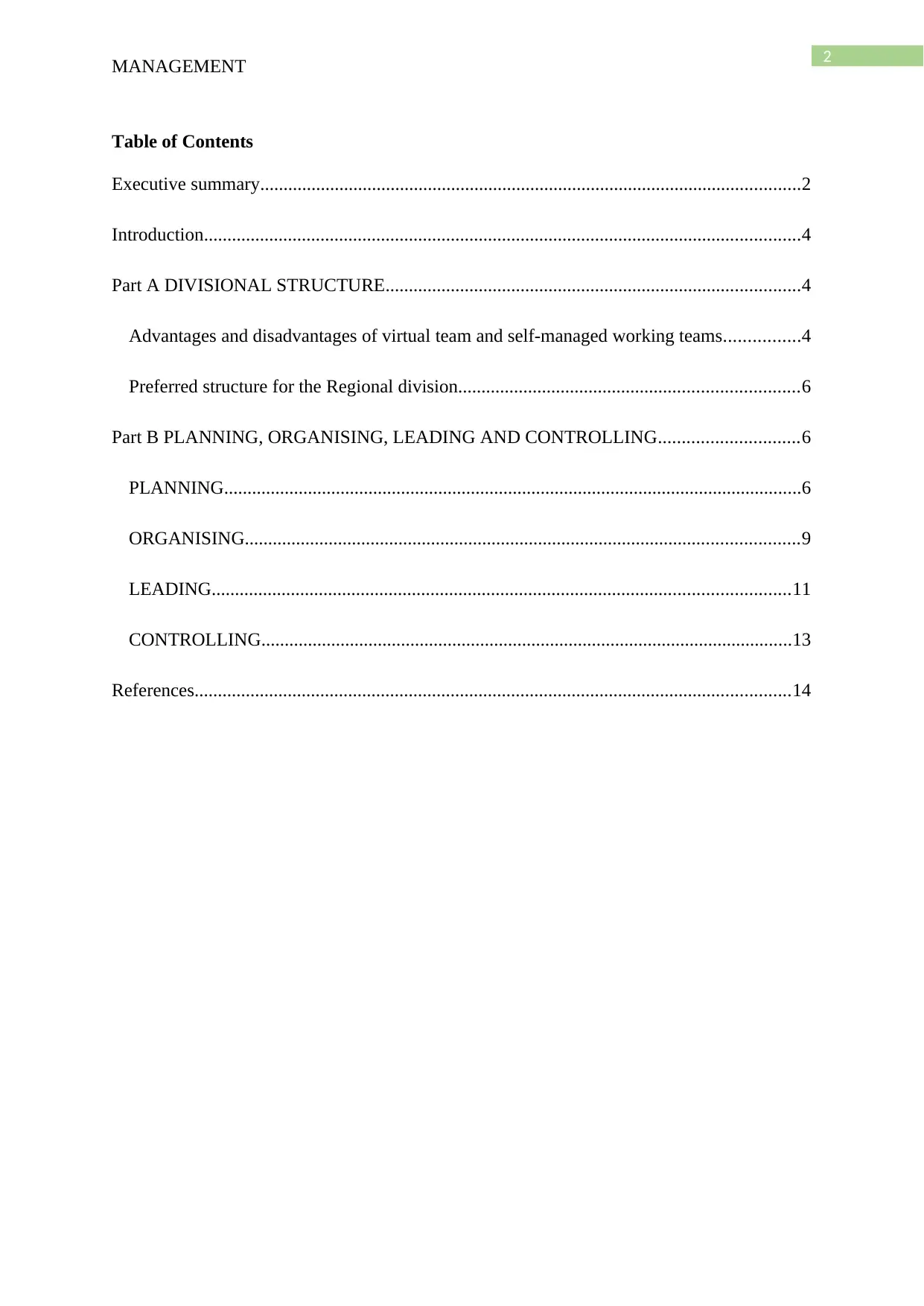
2
MANAGEMENT
Table of Contents
Executive summary....................................................................................................................2
Introduction................................................................................................................................4
Part A DIVISIONAL STRUCTURE.........................................................................................4
Advantages and disadvantages of virtual team and self-managed working teams................4
Preferred structure for the Regional division.........................................................................6
Part B PLANNING, ORGANISING, LEADING AND CONTROLLING..............................6
PLANNING............................................................................................................................6
ORGANISING.......................................................................................................................9
LEADING............................................................................................................................11
CONTROLLING..................................................................................................................13
References................................................................................................................................14
MANAGEMENT
Table of Contents
Executive summary....................................................................................................................2
Introduction................................................................................................................................4
Part A DIVISIONAL STRUCTURE.........................................................................................4
Advantages and disadvantages of virtual team and self-managed working teams................4
Preferred structure for the Regional division.........................................................................6
Part B PLANNING, ORGANISING, LEADING AND CONTROLLING..............................6
PLANNING............................................................................................................................6
ORGANISING.......................................................................................................................9
LEADING............................................................................................................................11
CONTROLLING..................................................................................................................13
References................................................................................................................................14
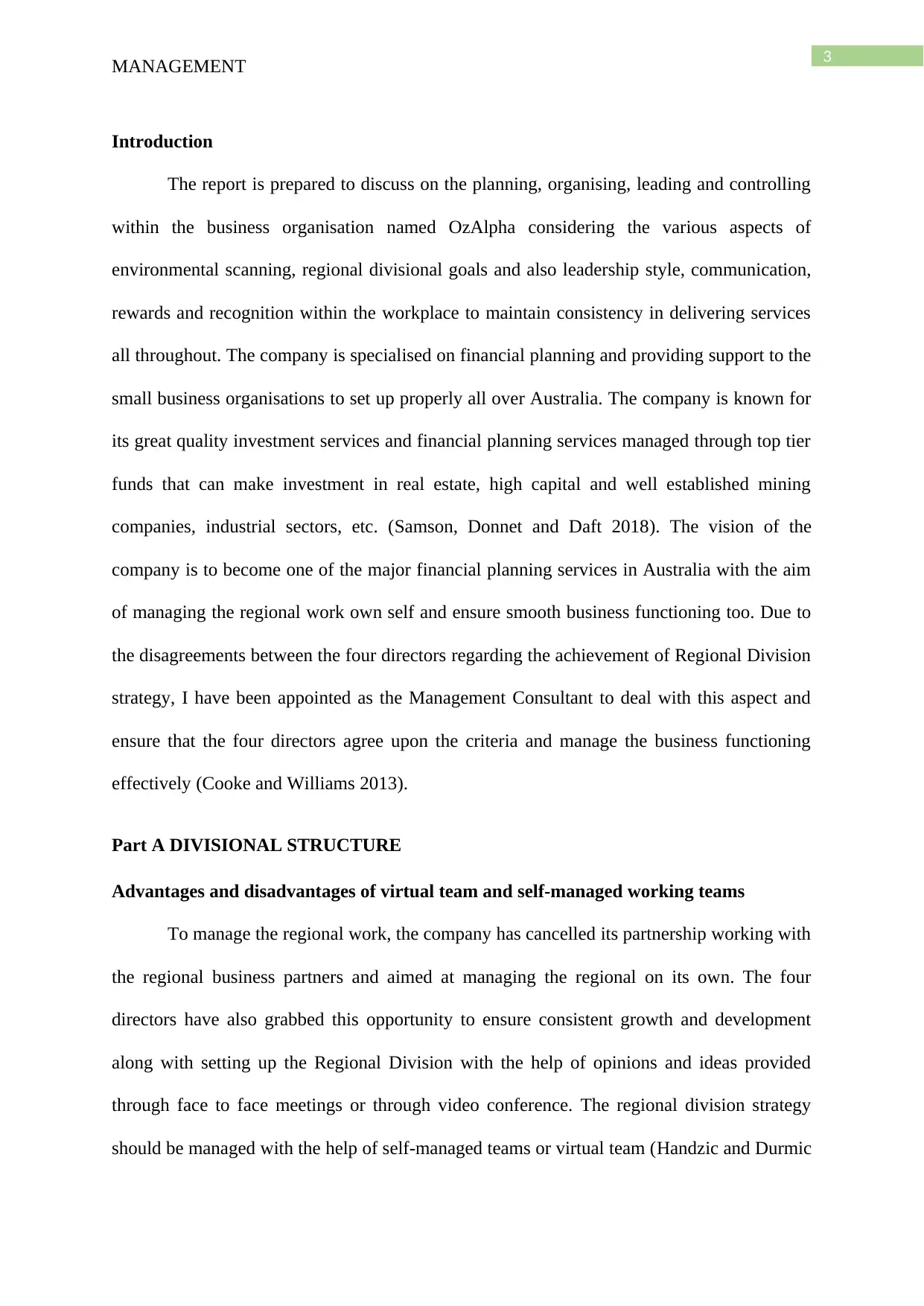
3
MANAGEMENT
Introduction
The report is prepared to discuss on the planning, organising, leading and controlling
within the business organisation named OzAlpha considering the various aspects of
environmental scanning, regional divisional goals and also leadership style, communication,
rewards and recognition within the workplace to maintain consistency in delivering services
all throughout. The company is specialised on financial planning and providing support to the
small business organisations to set up properly all over Australia. The company is known for
its great quality investment services and financial planning services managed through top tier
funds that can make investment in real estate, high capital and well established mining
companies, industrial sectors, etc. (Samson, Donnet and Daft 2018). The vision of the
company is to become one of the major financial planning services in Australia with the aim
of managing the regional work own self and ensure smooth business functioning too. Due to
the disagreements between the four directors regarding the achievement of Regional Division
strategy, I have been appointed as the Management Consultant to deal with this aspect and
ensure that the four directors agree upon the criteria and manage the business functioning
effectively (Cooke and Williams 2013).
Part A DIVISIONAL STRUCTURE
Advantages and disadvantages of virtual team and self-managed working teams
To manage the regional work, the company has cancelled its partnership working with
the regional business partners and aimed at managing the regional on its own. The four
directors have also grabbed this opportunity to ensure consistent growth and development
along with setting up the Regional Division with the help of opinions and ideas provided
through face to face meetings or through video conference. The regional division strategy
should be managed with the help of self-managed teams or virtual team (Handzic and Durmic
MANAGEMENT
Introduction
The report is prepared to discuss on the planning, organising, leading and controlling
within the business organisation named OzAlpha considering the various aspects of
environmental scanning, regional divisional goals and also leadership style, communication,
rewards and recognition within the workplace to maintain consistency in delivering services
all throughout. The company is specialised on financial planning and providing support to the
small business organisations to set up properly all over Australia. The company is known for
its great quality investment services and financial planning services managed through top tier
funds that can make investment in real estate, high capital and well established mining
companies, industrial sectors, etc. (Samson, Donnet and Daft 2018). The vision of the
company is to become one of the major financial planning services in Australia with the aim
of managing the regional work own self and ensure smooth business functioning too. Due to
the disagreements between the four directors regarding the achievement of Regional Division
strategy, I have been appointed as the Management Consultant to deal with this aspect and
ensure that the four directors agree upon the criteria and manage the business functioning
effectively (Cooke and Williams 2013).
Part A DIVISIONAL STRUCTURE
Advantages and disadvantages of virtual team and self-managed working teams
To manage the regional work, the company has cancelled its partnership working with
the regional business partners and aimed at managing the regional on its own. The four
directors have also grabbed this opportunity to ensure consistent growth and development
along with setting up the Regional Division with the help of opinions and ideas provided
through face to face meetings or through video conference. The regional division strategy
should be managed with the help of self-managed teams or virtual team (Handzic and Durmic
Secure Best Marks with AI Grader
Need help grading? Try our AI Grader for instant feedback on your assignments.
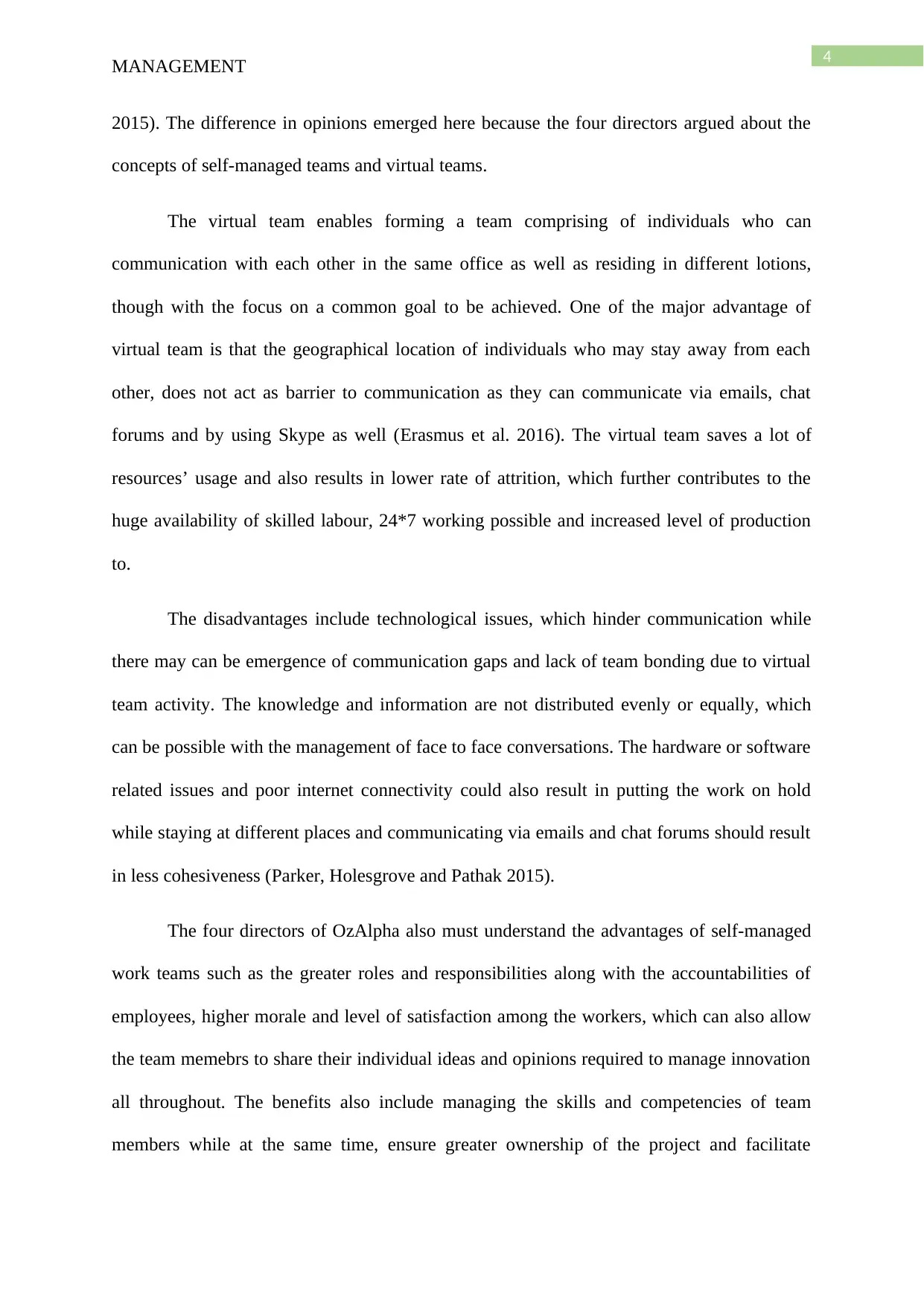
4
MANAGEMENT
2015). The difference in opinions emerged here because the four directors argued about the
concepts of self-managed teams and virtual teams.
The virtual team enables forming a team comprising of individuals who can
communication with each other in the same office as well as residing in different lotions,
though with the focus on a common goal to be achieved. One of the major advantage of
virtual team is that the geographical location of individuals who may stay away from each
other, does not act as barrier to communication as they can communicate via emails, chat
forums and by using Skype as well (Erasmus et al. 2016). The virtual team saves a lot of
resources’ usage and also results in lower rate of attrition, which further contributes to the
huge availability of skilled labour, 24*7 working possible and increased level of production
to.
The disadvantages include technological issues, which hinder communication while
there may can be emergence of communication gaps and lack of team bonding due to virtual
team activity. The knowledge and information are not distributed evenly or equally, which
can be possible with the management of face to face conversations. The hardware or software
related issues and poor internet connectivity could also result in putting the work on hold
while staying at different places and communicating via emails and chat forums should result
in less cohesiveness (Parker, Holesgrove and Pathak 2015).
The four directors of OzAlpha also must understand the advantages of self-managed
work teams such as the greater roles and responsibilities along with the accountabilities of
employees, higher morale and level of satisfaction among the workers, which can also allow
the team memebrs to share their individual ideas and opinions required to manage innovation
all throughout. The benefits also include managing the skills and competencies of team
members while at the same time, ensure greater ownership of the project and facilitate
MANAGEMENT
2015). The difference in opinions emerged here because the four directors argued about the
concepts of self-managed teams and virtual teams.
The virtual team enables forming a team comprising of individuals who can
communication with each other in the same office as well as residing in different lotions,
though with the focus on a common goal to be achieved. One of the major advantage of
virtual team is that the geographical location of individuals who may stay away from each
other, does not act as barrier to communication as they can communicate via emails, chat
forums and by using Skype as well (Erasmus et al. 2016). The virtual team saves a lot of
resources’ usage and also results in lower rate of attrition, which further contributes to the
huge availability of skilled labour, 24*7 working possible and increased level of production
to.
The disadvantages include technological issues, which hinder communication while
there may can be emergence of communication gaps and lack of team bonding due to virtual
team activity. The knowledge and information are not distributed evenly or equally, which
can be possible with the management of face to face conversations. The hardware or software
related issues and poor internet connectivity could also result in putting the work on hold
while staying at different places and communicating via emails and chat forums should result
in less cohesiveness (Parker, Holesgrove and Pathak 2015).
The four directors of OzAlpha also must understand the advantages of self-managed
work teams such as the greater roles and responsibilities along with the accountabilities of
employees, higher morale and level of satisfaction among the workers, which can also allow
the team memebrs to share their individual ideas and opinions required to manage innovation
all throughout. The benefits also include managing the skills and competencies of team
members while at the same time, ensure greater ownership of the project and facilitate
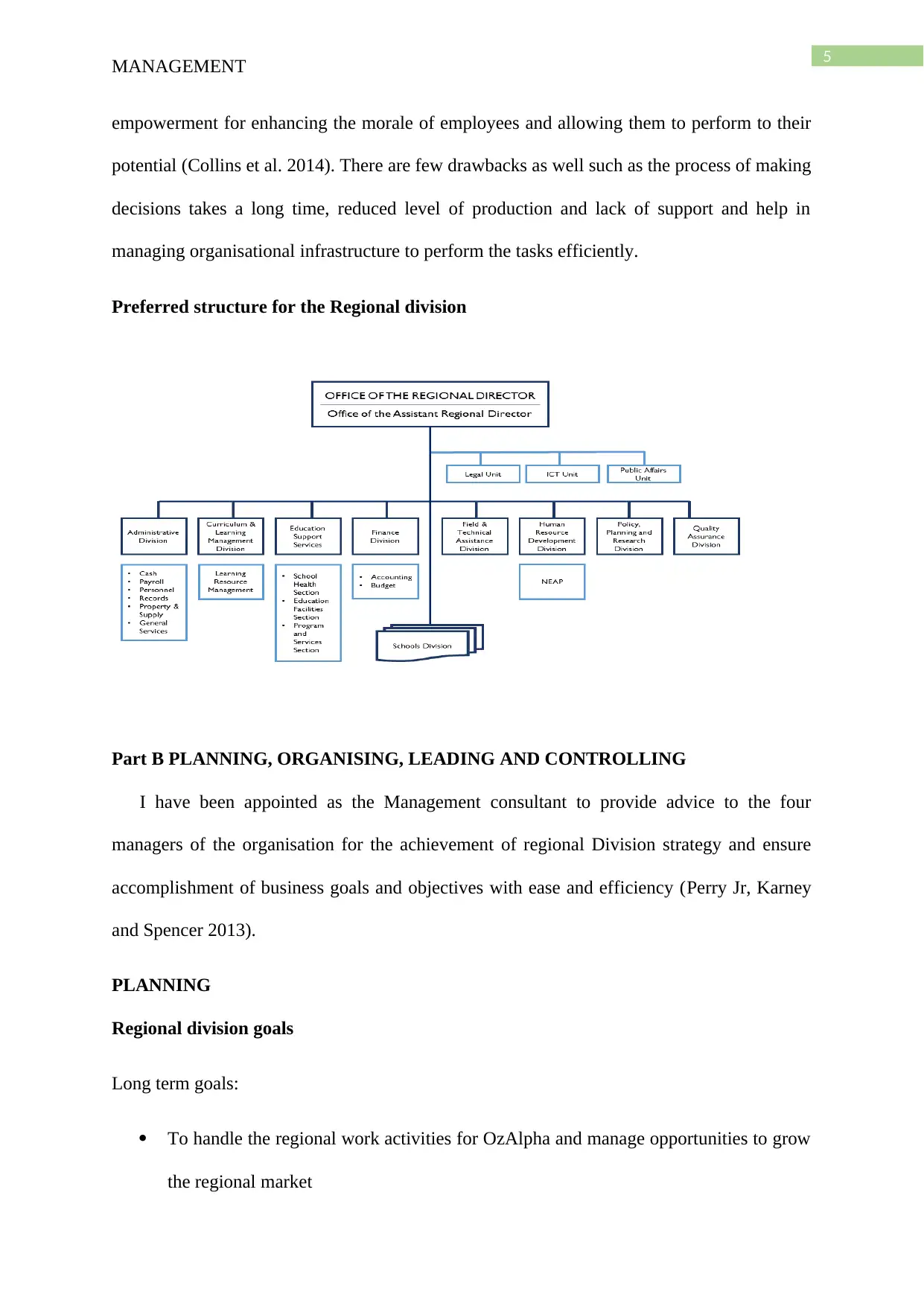
5
MANAGEMENT
empowerment for enhancing the morale of employees and allowing them to perform to their
potential (Collins et al. 2014). There are few drawbacks as well such as the process of making
decisions takes a long time, reduced level of production and lack of support and help in
managing organisational infrastructure to perform the tasks efficiently.
Preferred structure for the Regional division
Part B PLANNING, ORGANISING, LEADING AND CONTROLLING
I have been appointed as the Management consultant to provide advice to the four
managers of the organisation for the achievement of regional Division strategy and ensure
accomplishment of business goals and objectives with ease and efficiency (Perry Jr, Karney
and Spencer 2013).
PLANNING
Regional division goals
Long term goals:
To handle the regional work activities for OzAlpha and manage opportunities to grow
the regional market
MANAGEMENT
empowerment for enhancing the morale of employees and allowing them to perform to their
potential (Collins et al. 2014). There are few drawbacks as well such as the process of making
decisions takes a long time, reduced level of production and lack of support and help in
managing organisational infrastructure to perform the tasks efficiently.
Preferred structure for the Regional division
Part B PLANNING, ORGANISING, LEADING AND CONTROLLING
I have been appointed as the Management consultant to provide advice to the four
managers of the organisation for the achievement of regional Division strategy and ensure
accomplishment of business goals and objectives with ease and efficiency (Perry Jr, Karney
and Spencer 2013).
PLANNING
Regional division goals
Long term goals:
To handle the regional work activities for OzAlpha and manage opportunities to grow
the regional market
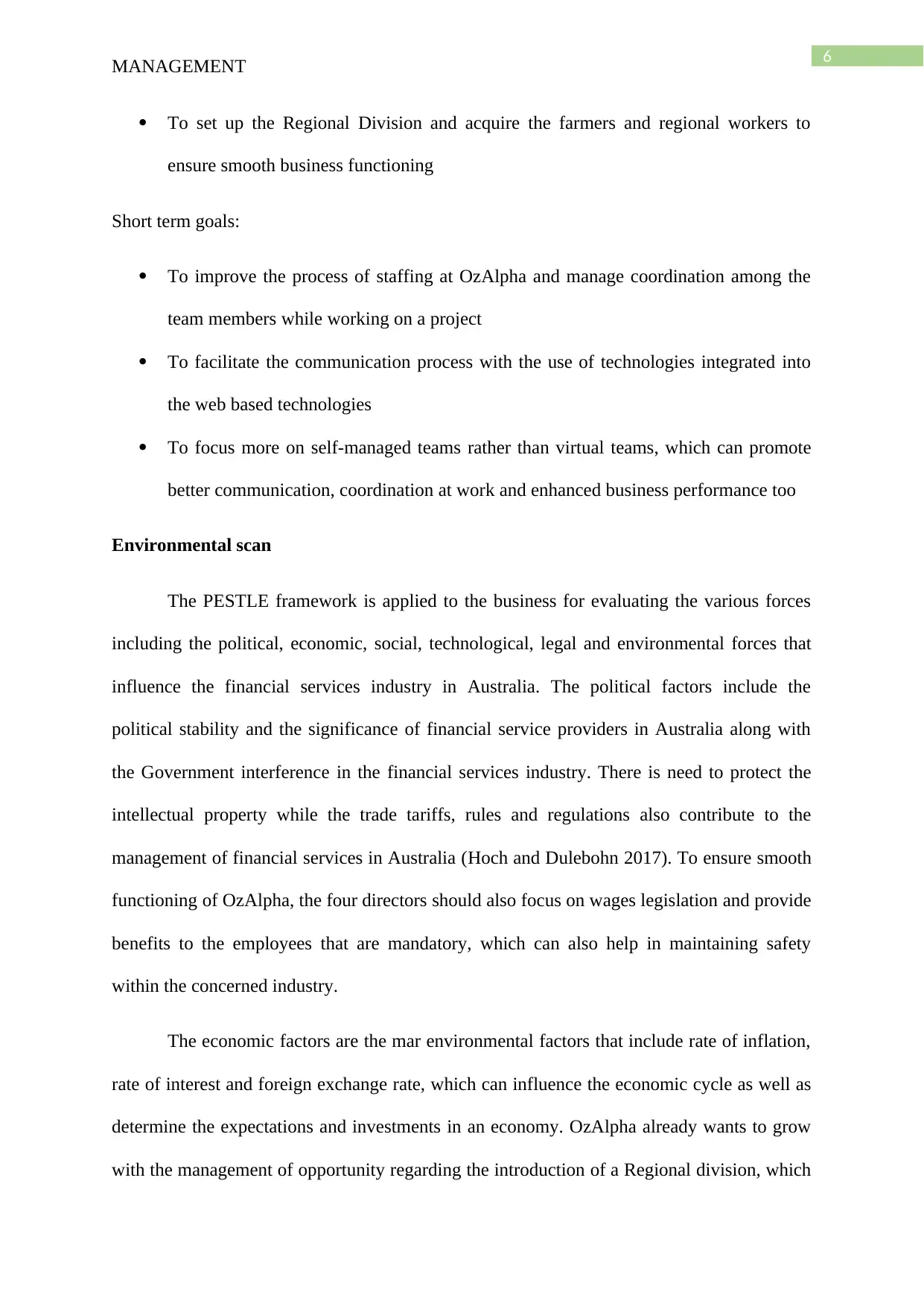
6
MANAGEMENT
To set up the Regional Division and acquire the farmers and regional workers to
ensure smooth business functioning
Short term goals:
To improve the process of staffing at OzAlpha and manage coordination among the
team members while working on a project
To facilitate the communication process with the use of technologies integrated into
the web based technologies
To focus more on self-managed teams rather than virtual teams, which can promote
better communication, coordination at work and enhanced business performance too
Environmental scan
The PESTLE framework is applied to the business for evaluating the various forces
including the political, economic, social, technological, legal and environmental forces that
influence the financial services industry in Australia. The political factors include the
political stability and the significance of financial service providers in Australia along with
the Government interference in the financial services industry. There is need to protect the
intellectual property while the trade tariffs, rules and regulations also contribute to the
management of financial services in Australia (Hoch and Dulebohn 2017). To ensure smooth
functioning of OzAlpha, the four directors should also focus on wages legislation and provide
benefits to the employees that are mandatory, which can also help in maintaining safety
within the concerned industry.
The economic factors are the mar environmental factors that include rate of inflation,
rate of interest and foreign exchange rate, which can influence the economic cycle as well as
determine the expectations and investments in an economy. OzAlpha already wants to grow
with the management of opportunity regarding the introduction of a Regional division, which
MANAGEMENT
To set up the Regional Division and acquire the farmers and regional workers to
ensure smooth business functioning
Short term goals:
To improve the process of staffing at OzAlpha and manage coordination among the
team members while working on a project
To facilitate the communication process with the use of technologies integrated into
the web based technologies
To focus more on self-managed teams rather than virtual teams, which can promote
better communication, coordination at work and enhanced business performance too
Environmental scan
The PESTLE framework is applied to the business for evaluating the various forces
including the political, economic, social, technological, legal and environmental forces that
influence the financial services industry in Australia. The political factors include the
political stability and the significance of financial service providers in Australia along with
the Government interference in the financial services industry. There is need to protect the
intellectual property while the trade tariffs, rules and regulations also contribute to the
management of financial services in Australia (Hoch and Dulebohn 2017). To ensure smooth
functioning of OzAlpha, the four directors should also focus on wages legislation and provide
benefits to the employees that are mandatory, which can also help in maintaining safety
within the concerned industry.
The economic factors are the mar environmental factors that include rate of inflation,
rate of interest and foreign exchange rate, which can influence the economic cycle as well as
determine the expectations and investments in an economy. OzAlpha already wants to grow
with the management of opportunity regarding the introduction of a Regional division, which
Paraphrase This Document
Need a fresh take? Get an instant paraphrase of this document with our AI Paraphraser
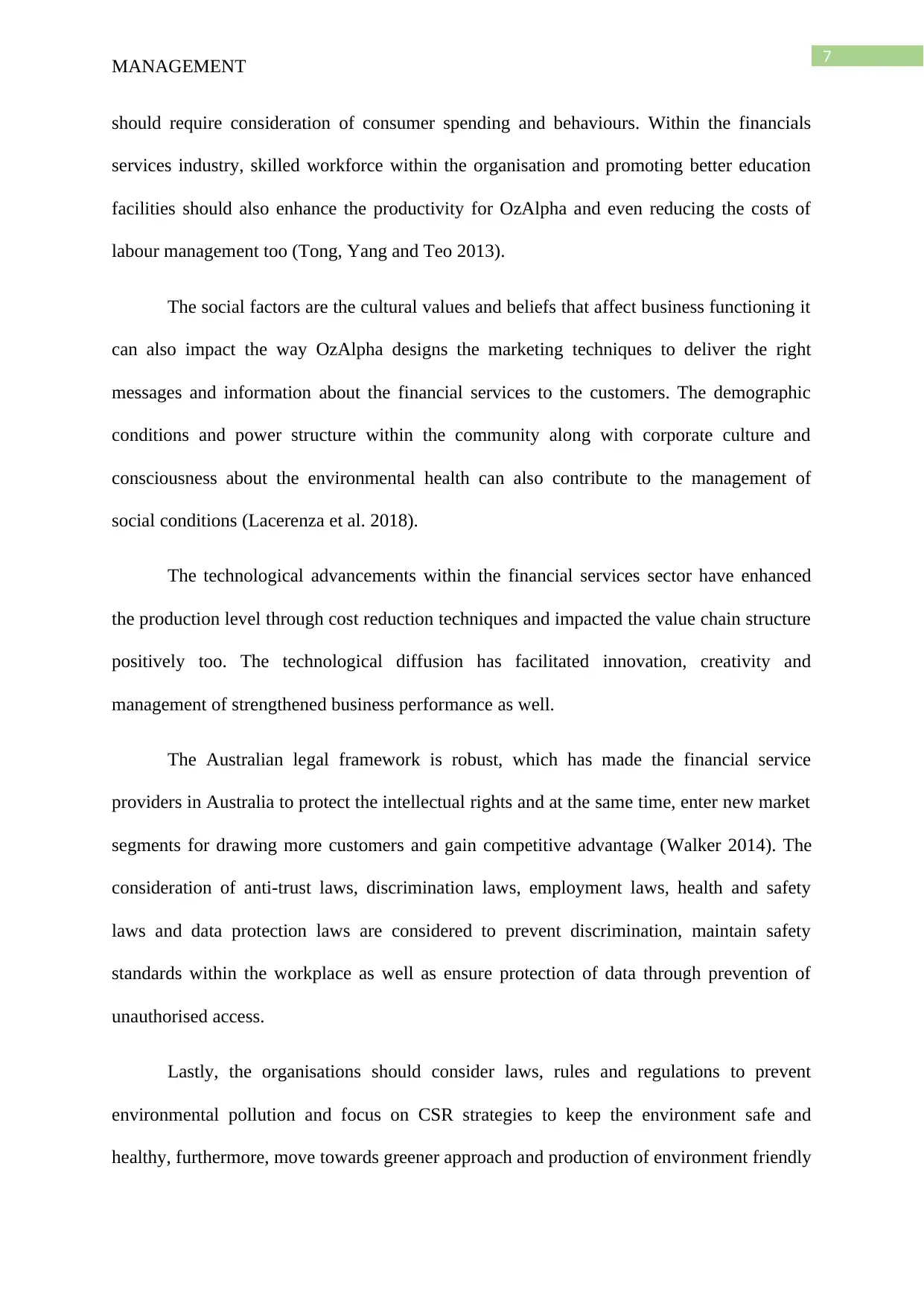
7
MANAGEMENT
should require consideration of consumer spending and behaviours. Within the financials
services industry, skilled workforce within the organisation and promoting better education
facilities should also enhance the productivity for OzAlpha and even reducing the costs of
labour management too (Tong, Yang and Teo 2013).
The social factors are the cultural values and beliefs that affect business functioning it
can also impact the way OzAlpha designs the marketing techniques to deliver the right
messages and information about the financial services to the customers. The demographic
conditions and power structure within the community along with corporate culture and
consciousness about the environmental health can also contribute to the management of
social conditions (Lacerenza et al. 2018).
The technological advancements within the financial services sector have enhanced
the production level through cost reduction techniques and impacted the value chain structure
positively too. The technological diffusion has facilitated innovation, creativity and
management of strengthened business performance as well.
The Australian legal framework is robust, which has made the financial service
providers in Australia to protect the intellectual rights and at the same time, enter new market
segments for drawing more customers and gain competitive advantage (Walker 2014). The
consideration of anti-trust laws, discrimination laws, employment laws, health and safety
laws and data protection laws are considered to prevent discrimination, maintain safety
standards within the workplace as well as ensure protection of data through prevention of
unauthorised access.
Lastly, the organisations should consider laws, rules and regulations to prevent
environmental pollution and focus on CSR strategies to keep the environment safe and
healthy, furthermore, move towards greener approach and production of environment friendly
MANAGEMENT
should require consideration of consumer spending and behaviours. Within the financials
services industry, skilled workforce within the organisation and promoting better education
facilities should also enhance the productivity for OzAlpha and even reducing the costs of
labour management too (Tong, Yang and Teo 2013).
The social factors are the cultural values and beliefs that affect business functioning it
can also impact the way OzAlpha designs the marketing techniques to deliver the right
messages and information about the financial services to the customers. The demographic
conditions and power structure within the community along with corporate culture and
consciousness about the environmental health can also contribute to the management of
social conditions (Lacerenza et al. 2018).
The technological advancements within the financial services sector have enhanced
the production level through cost reduction techniques and impacted the value chain structure
positively too. The technological diffusion has facilitated innovation, creativity and
management of strengthened business performance as well.
The Australian legal framework is robust, which has made the financial service
providers in Australia to protect the intellectual rights and at the same time, enter new market
segments for drawing more customers and gain competitive advantage (Walker 2014). The
consideration of anti-trust laws, discrimination laws, employment laws, health and safety
laws and data protection laws are considered to prevent discrimination, maintain safety
standards within the workplace as well as ensure protection of data through prevention of
unauthorised access.
Lastly, the organisations should consider laws, rules and regulations to prevent
environmental pollution and focus on CSR strategies to keep the environment safe and
healthy, furthermore, move towards greener approach and production of environment friendly
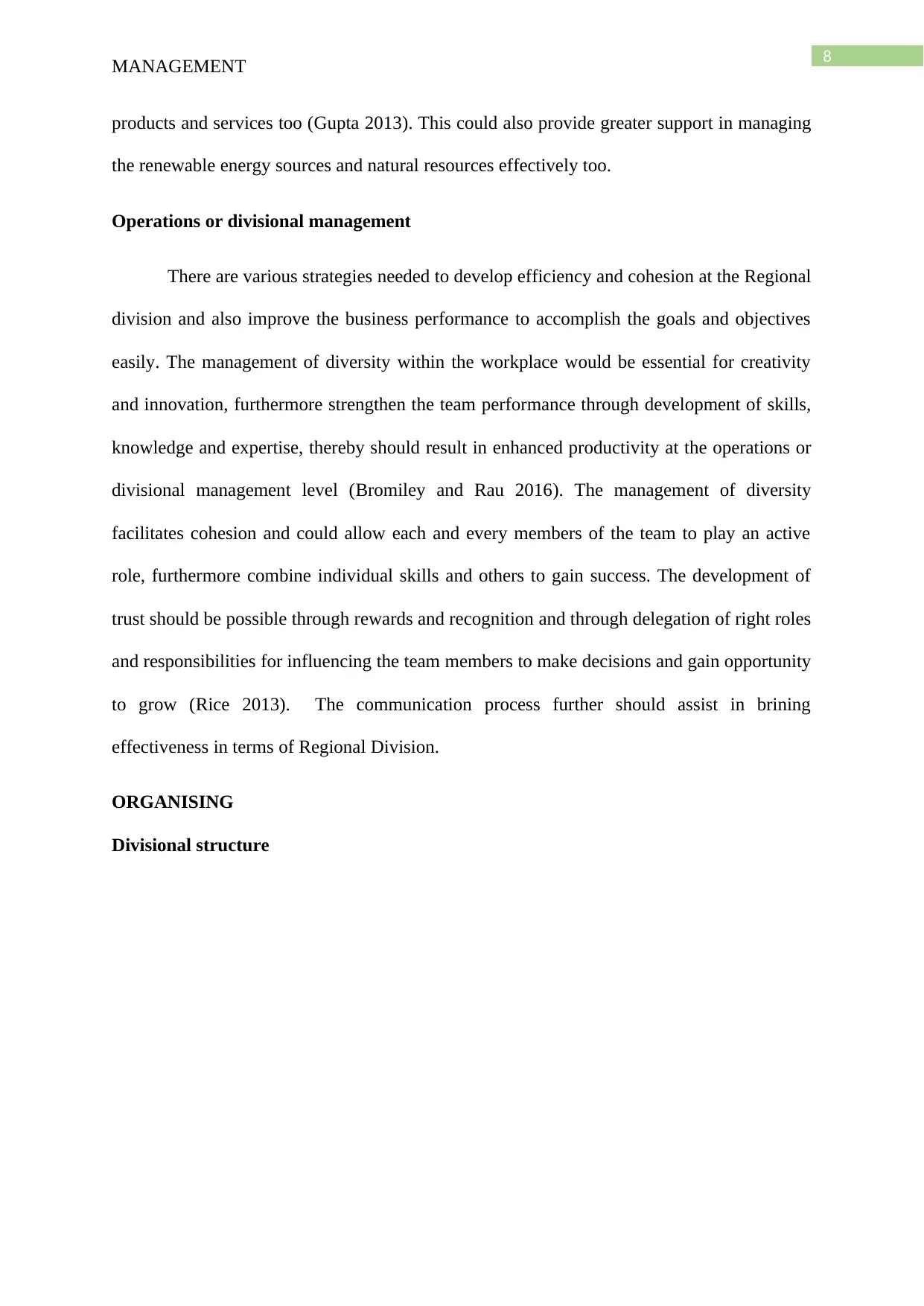
8
MANAGEMENT
products and services too (Gupta 2013). This could also provide greater support in managing
the renewable energy sources and natural resources effectively too.
Operations or divisional management
There are various strategies needed to develop efficiency and cohesion at the Regional
division and also improve the business performance to accomplish the goals and objectives
easily. The management of diversity within the workplace would be essential for creativity
and innovation, furthermore strengthen the team performance through development of skills,
knowledge and expertise, thereby should result in enhanced productivity at the operations or
divisional management level (Bromiley and Rau 2016). The management of diversity
facilitates cohesion and could allow each and every members of the team to play an active
role, furthermore combine individual skills and others to gain success. The development of
trust should be possible through rewards and recognition and through delegation of right roles
and responsibilities for influencing the team members to make decisions and gain opportunity
to grow (Rice 2013). The communication process further should assist in brining
effectiveness in terms of Regional Division.
ORGANISING
Divisional structure
MANAGEMENT
products and services too (Gupta 2013). This could also provide greater support in managing
the renewable energy sources and natural resources effectively too.
Operations or divisional management
There are various strategies needed to develop efficiency and cohesion at the Regional
division and also improve the business performance to accomplish the goals and objectives
easily. The management of diversity within the workplace would be essential for creativity
and innovation, furthermore strengthen the team performance through development of skills,
knowledge and expertise, thereby should result in enhanced productivity at the operations or
divisional management level (Bromiley and Rau 2016). The management of diversity
facilitates cohesion and could allow each and every members of the team to play an active
role, furthermore combine individual skills and others to gain success. The development of
trust should be possible through rewards and recognition and through delegation of right roles
and responsibilities for influencing the team members to make decisions and gain opportunity
to grow (Rice 2013). The communication process further should assist in brining
effectiveness in terms of Regional Division.
ORGANISING
Divisional structure
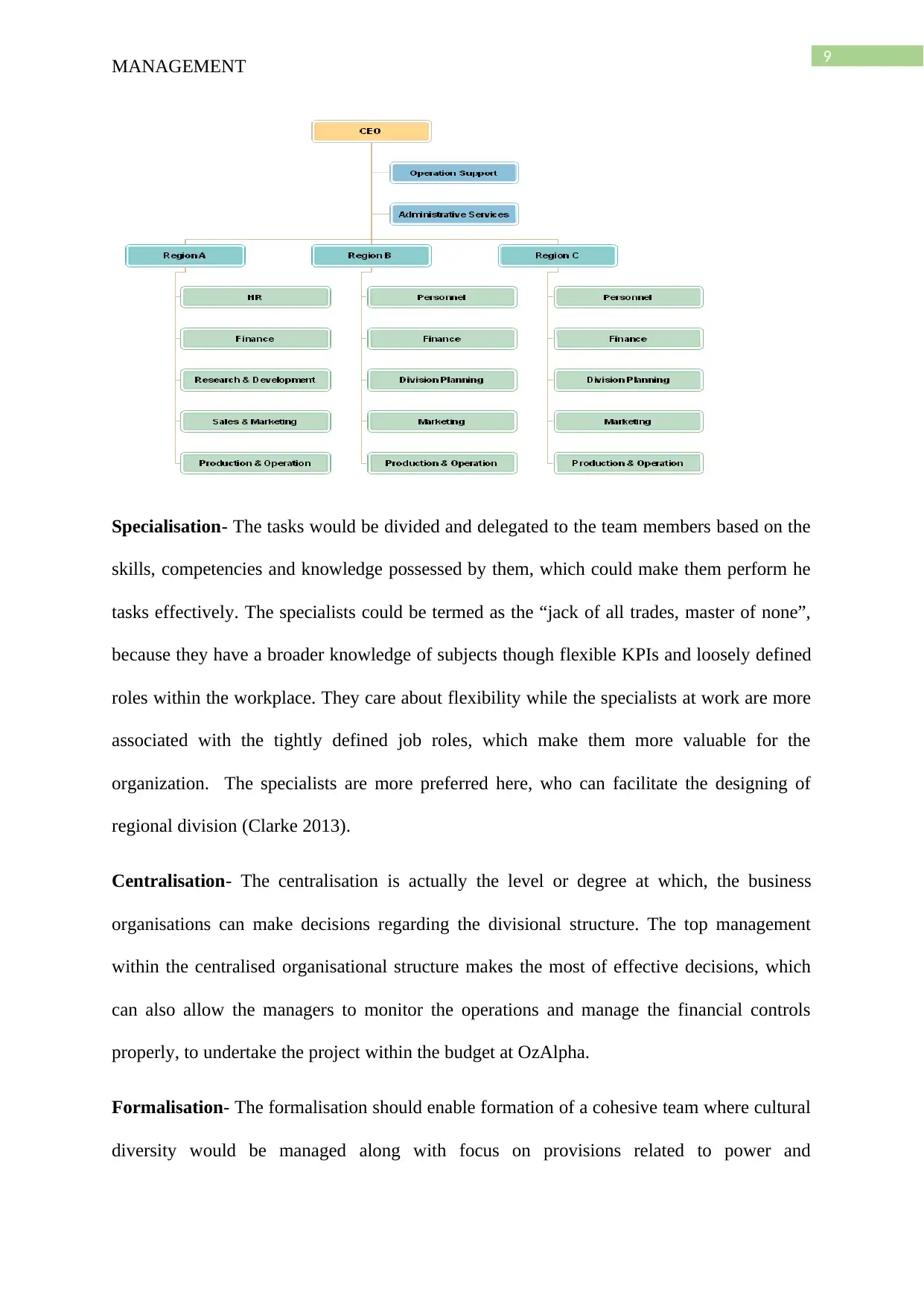
9
MANAGEMENT
Specialisation- The tasks would be divided and delegated to the team members based on the
skills, competencies and knowledge possessed by them, which could make them perform he
tasks effectively. The specialists could be termed as the “jack of all trades, master of none”,
because they have a broader knowledge of subjects though flexible KPIs and loosely defined
roles within the workplace. They care about flexibility while the specialists at work are more
associated with the tightly defined job roles, which make them more valuable for the
organization. The specialists are more preferred here, who can facilitate the designing of
regional division (Clarke 2013).
Centralisation- The centralisation is actually the level or degree at which, the business
organisations can make decisions regarding the divisional structure. The top management
within the centralised organisational structure makes the most of effective decisions, which
can also allow the managers to monitor the operations and manage the financial controls
properly, to undertake the project within the budget at OzAlpha.
Formalisation- The formalisation should enable formation of a cohesive team where cultural
diversity would be managed along with focus on provisions related to power and
MANAGEMENT
Specialisation- The tasks would be divided and delegated to the team members based on the
skills, competencies and knowledge possessed by them, which could make them perform he
tasks effectively. The specialists could be termed as the “jack of all trades, master of none”,
because they have a broader knowledge of subjects though flexible KPIs and loosely defined
roles within the workplace. They care about flexibility while the specialists at work are more
associated with the tightly defined job roles, which make them more valuable for the
organization. The specialists are more preferred here, who can facilitate the designing of
regional division (Clarke 2013).
Centralisation- The centralisation is actually the level or degree at which, the business
organisations can make decisions regarding the divisional structure. The top management
within the centralised organisational structure makes the most of effective decisions, which
can also allow the managers to monitor the operations and manage the financial controls
properly, to undertake the project within the budget at OzAlpha.
Formalisation- The formalisation should enable formation of a cohesive team where cultural
diversity would be managed along with focus on provisions related to power and
Secure Best Marks with AI Grader
Need help grading? Try our AI Grader for instant feedback on your assignments.
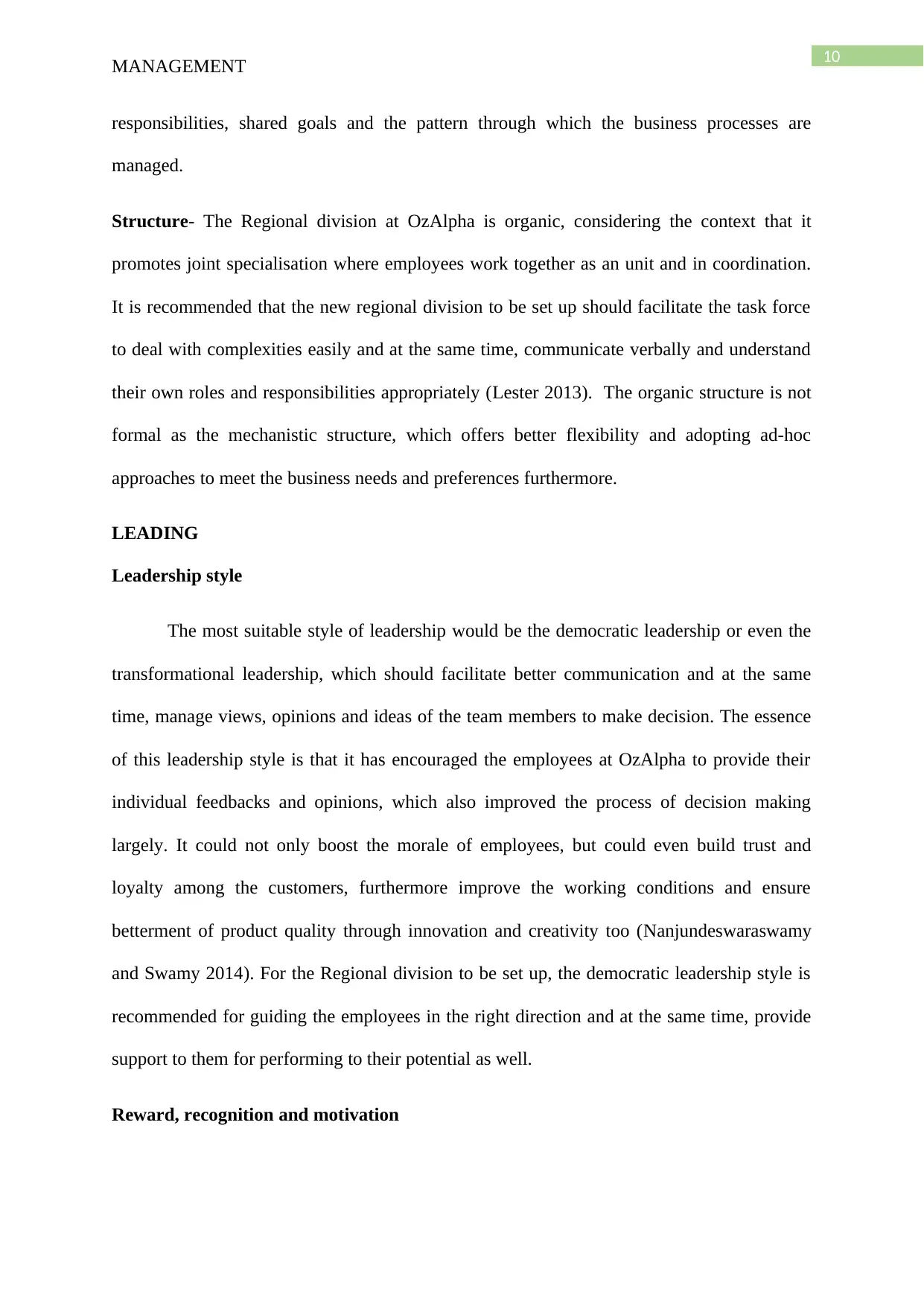
10
MANAGEMENT
responsibilities, shared goals and the pattern through which the business processes are
managed.
Structure- The Regional division at OzAlpha is organic, considering the context that it
promotes joint specialisation where employees work together as an unit and in coordination.
It is recommended that the new regional division to be set up should facilitate the task force
to deal with complexities easily and at the same time, communicate verbally and understand
their own roles and responsibilities appropriately (Lester 2013). The organic structure is not
formal as the mechanistic structure, which offers better flexibility and adopting ad-hoc
approaches to meet the business needs and preferences furthermore.
LEADING
Leadership style
The most suitable style of leadership would be the democratic leadership or even the
transformational leadership, which should facilitate better communication and at the same
time, manage views, opinions and ideas of the team members to make decision. The essence
of this leadership style is that it has encouraged the employees at OzAlpha to provide their
individual feedbacks and opinions, which also improved the process of decision making
largely. It could not only boost the morale of employees, but could even build trust and
loyalty among the customers, furthermore improve the working conditions and ensure
betterment of product quality through innovation and creativity too (Nanjundeswaraswamy
and Swamy 2014). For the Regional division to be set up, the democratic leadership style is
recommended for guiding the employees in the right direction and at the same time, provide
support to them for performing to their potential as well.
Reward, recognition and motivation
MANAGEMENT
responsibilities, shared goals and the pattern through which the business processes are
managed.
Structure- The Regional division at OzAlpha is organic, considering the context that it
promotes joint specialisation where employees work together as an unit and in coordination.
It is recommended that the new regional division to be set up should facilitate the task force
to deal with complexities easily and at the same time, communicate verbally and understand
their own roles and responsibilities appropriately (Lester 2013). The organic structure is not
formal as the mechanistic structure, which offers better flexibility and adopting ad-hoc
approaches to meet the business needs and preferences furthermore.
LEADING
Leadership style
The most suitable style of leadership would be the democratic leadership or even the
transformational leadership, which should facilitate better communication and at the same
time, manage views, opinions and ideas of the team members to make decision. The essence
of this leadership style is that it has encouraged the employees at OzAlpha to provide their
individual feedbacks and opinions, which also improved the process of decision making
largely. It could not only boost the morale of employees, but could even build trust and
loyalty among the customers, furthermore improve the working conditions and ensure
betterment of product quality through innovation and creativity too (Nanjundeswaraswamy
and Swamy 2014). For the Regional division to be set up, the democratic leadership style is
recommended for guiding the employees in the right direction and at the same time, provide
support to them for performing to their potential as well.
Reward, recognition and motivation
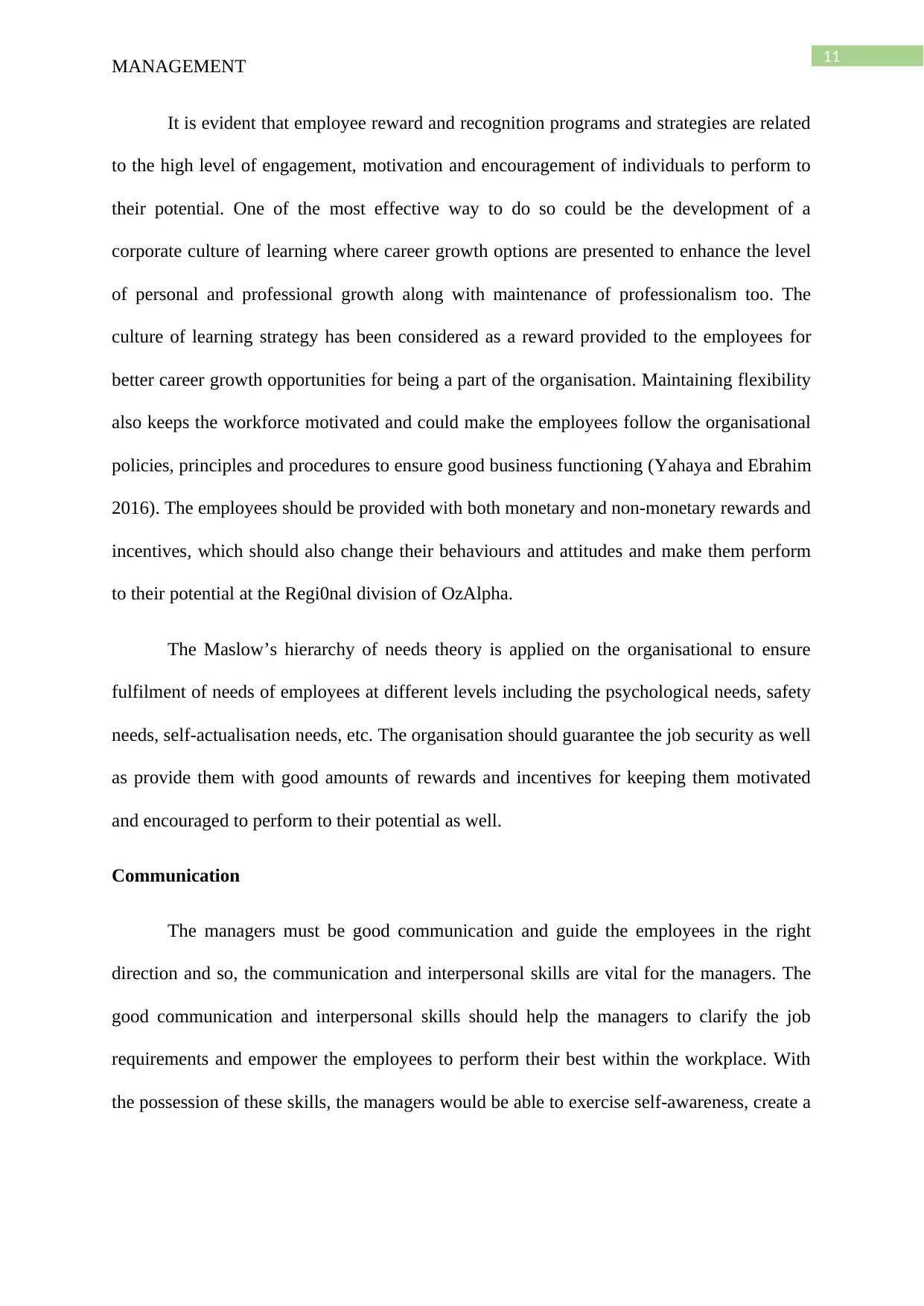
11
MANAGEMENT
It is evident that employee reward and recognition programs and strategies are related
to the high level of engagement, motivation and encouragement of individuals to perform to
their potential. One of the most effective way to do so could be the development of a
corporate culture of learning where career growth options are presented to enhance the level
of personal and professional growth along with maintenance of professionalism too. The
culture of learning strategy has been considered as a reward provided to the employees for
better career growth opportunities for being a part of the organisation. Maintaining flexibility
also keeps the workforce motivated and could make the employees follow the organisational
policies, principles and procedures to ensure good business functioning (Yahaya and Ebrahim
2016). The employees should be provided with both monetary and non-monetary rewards and
incentives, which should also change their behaviours and attitudes and make them perform
to their potential at the Regi0nal division of OzAlpha.
The Maslow’s hierarchy of needs theory is applied on the organisational to ensure
fulfilment of needs of employees at different levels including the psychological needs, safety
needs, self-actualisation needs, etc. The organisation should guarantee the job security as well
as provide them with good amounts of rewards and incentives for keeping them motivated
and encouraged to perform to their potential as well.
Communication
The managers must be good communication and guide the employees in the right
direction and so, the communication and interpersonal skills are vital for the managers. The
good communication and interpersonal skills should help the managers to clarify the job
requirements and empower the employees to perform their best within the workplace. With
the possession of these skills, the managers would be able to exercise self-awareness, create a
MANAGEMENT
It is evident that employee reward and recognition programs and strategies are related
to the high level of engagement, motivation and encouragement of individuals to perform to
their potential. One of the most effective way to do so could be the development of a
corporate culture of learning where career growth options are presented to enhance the level
of personal and professional growth along with maintenance of professionalism too. The
culture of learning strategy has been considered as a reward provided to the employees for
better career growth opportunities for being a part of the organisation. Maintaining flexibility
also keeps the workforce motivated and could make the employees follow the organisational
policies, principles and procedures to ensure good business functioning (Yahaya and Ebrahim
2016). The employees should be provided with both monetary and non-monetary rewards and
incentives, which should also change their behaviours and attitudes and make them perform
to their potential at the Regi0nal division of OzAlpha.
The Maslow’s hierarchy of needs theory is applied on the organisational to ensure
fulfilment of needs of employees at different levels including the psychological needs, safety
needs, self-actualisation needs, etc. The organisation should guarantee the job security as well
as provide them with good amounts of rewards and incentives for keeping them motivated
and encouraged to perform to their potential as well.
Communication
The managers must be good communication and guide the employees in the right
direction and so, the communication and interpersonal skills are vital for the managers. The
good communication and interpersonal skills should help the managers to clarify the job
requirements and empower the employees to perform their best within the workplace. With
the possession of these skills, the managers would be able to exercise self-awareness, create a
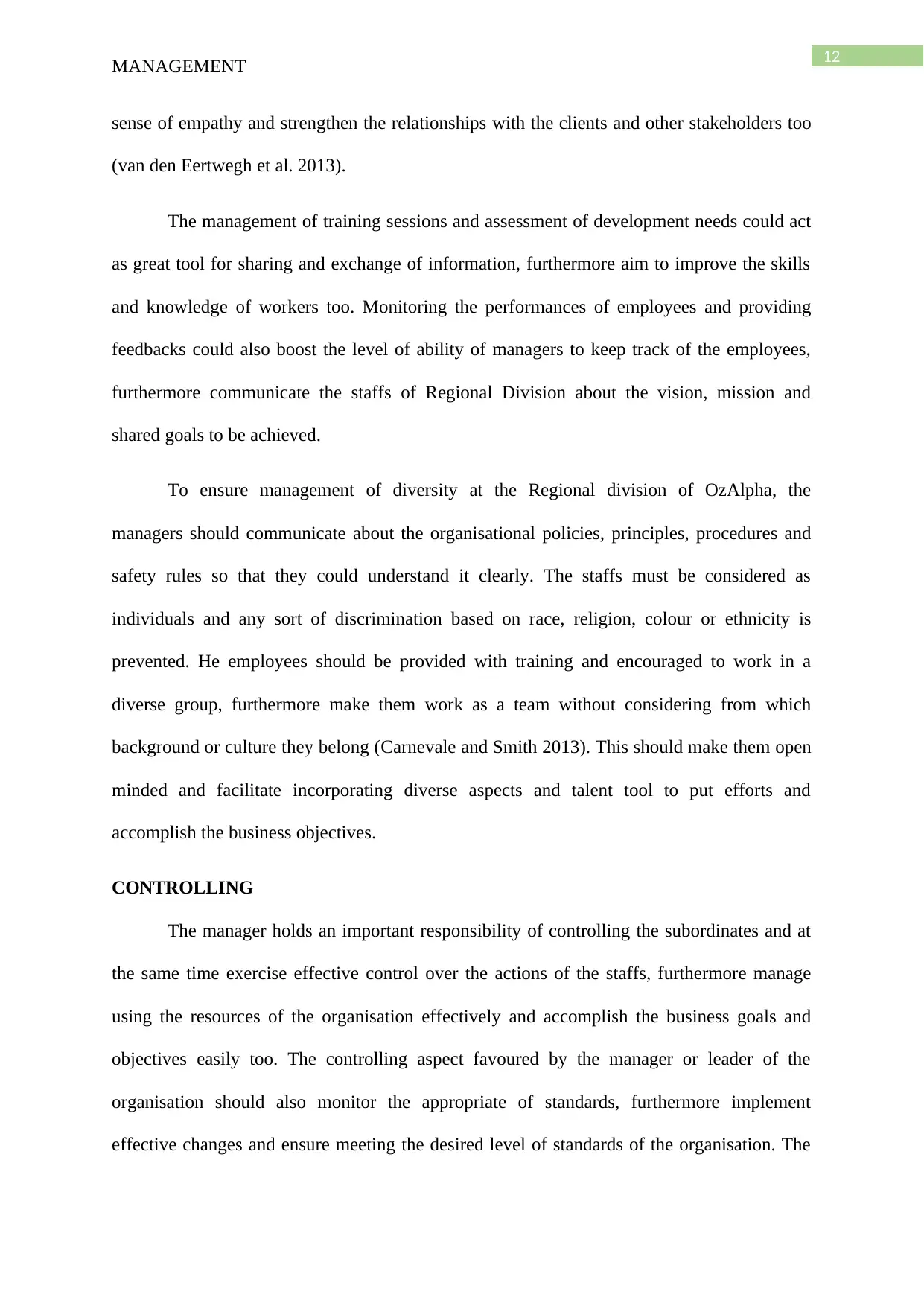
12
MANAGEMENT
sense of empathy and strengthen the relationships with the clients and other stakeholders too
(van den Eertwegh et al. 2013).
The management of training sessions and assessment of development needs could act
as great tool for sharing and exchange of information, furthermore aim to improve the skills
and knowledge of workers too. Monitoring the performances of employees and providing
feedbacks could also boost the level of ability of managers to keep track of the employees,
furthermore communicate the staffs of Regional Division about the vision, mission and
shared goals to be achieved.
To ensure management of diversity at the Regional division of OzAlpha, the
managers should communicate about the organisational policies, principles, procedures and
safety rules so that they could understand it clearly. The staffs must be considered as
individuals and any sort of discrimination based on race, religion, colour or ethnicity is
prevented. He employees should be provided with training and encouraged to work in a
diverse group, furthermore make them work as a team without considering from which
background or culture they belong (Carnevale and Smith 2013). This should make them open
minded and facilitate incorporating diverse aspects and talent tool to put efforts and
accomplish the business objectives.
CONTROLLING
The manager holds an important responsibility of controlling the subordinates and at
the same time exercise effective control over the actions of the staffs, furthermore manage
using the resources of the organisation effectively and accomplish the business goals and
objectives easily too. The controlling aspect favoured by the manager or leader of the
organisation should also monitor the appropriate of standards, furthermore implement
effective changes and ensure meeting the desired level of standards of the organisation. The
MANAGEMENT
sense of empathy and strengthen the relationships with the clients and other stakeholders too
(van den Eertwegh et al. 2013).
The management of training sessions and assessment of development needs could act
as great tool for sharing and exchange of information, furthermore aim to improve the skills
and knowledge of workers too. Monitoring the performances of employees and providing
feedbacks could also boost the level of ability of managers to keep track of the employees,
furthermore communicate the staffs of Regional Division about the vision, mission and
shared goals to be achieved.
To ensure management of diversity at the Regional division of OzAlpha, the
managers should communicate about the organisational policies, principles, procedures and
safety rules so that they could understand it clearly. The staffs must be considered as
individuals and any sort of discrimination based on race, religion, colour or ethnicity is
prevented. He employees should be provided with training and encouraged to work in a
diverse group, furthermore make them work as a team without considering from which
background or culture they belong (Carnevale and Smith 2013). This should make them open
minded and facilitate incorporating diverse aspects and talent tool to put efforts and
accomplish the business objectives.
CONTROLLING
The manager holds an important responsibility of controlling the subordinates and at
the same time exercise effective control over the actions of the staffs, furthermore manage
using the resources of the organisation effectively and accomplish the business goals and
objectives easily too. The controlling aspect favoured by the manager or leader of the
organisation should also monitor the appropriate of standards, furthermore implement
effective changes and ensure meeting the desired level of standards of the organisation. The
Paraphrase This Document
Need a fresh take? Get an instant paraphrase of this document with our AI Paraphraser
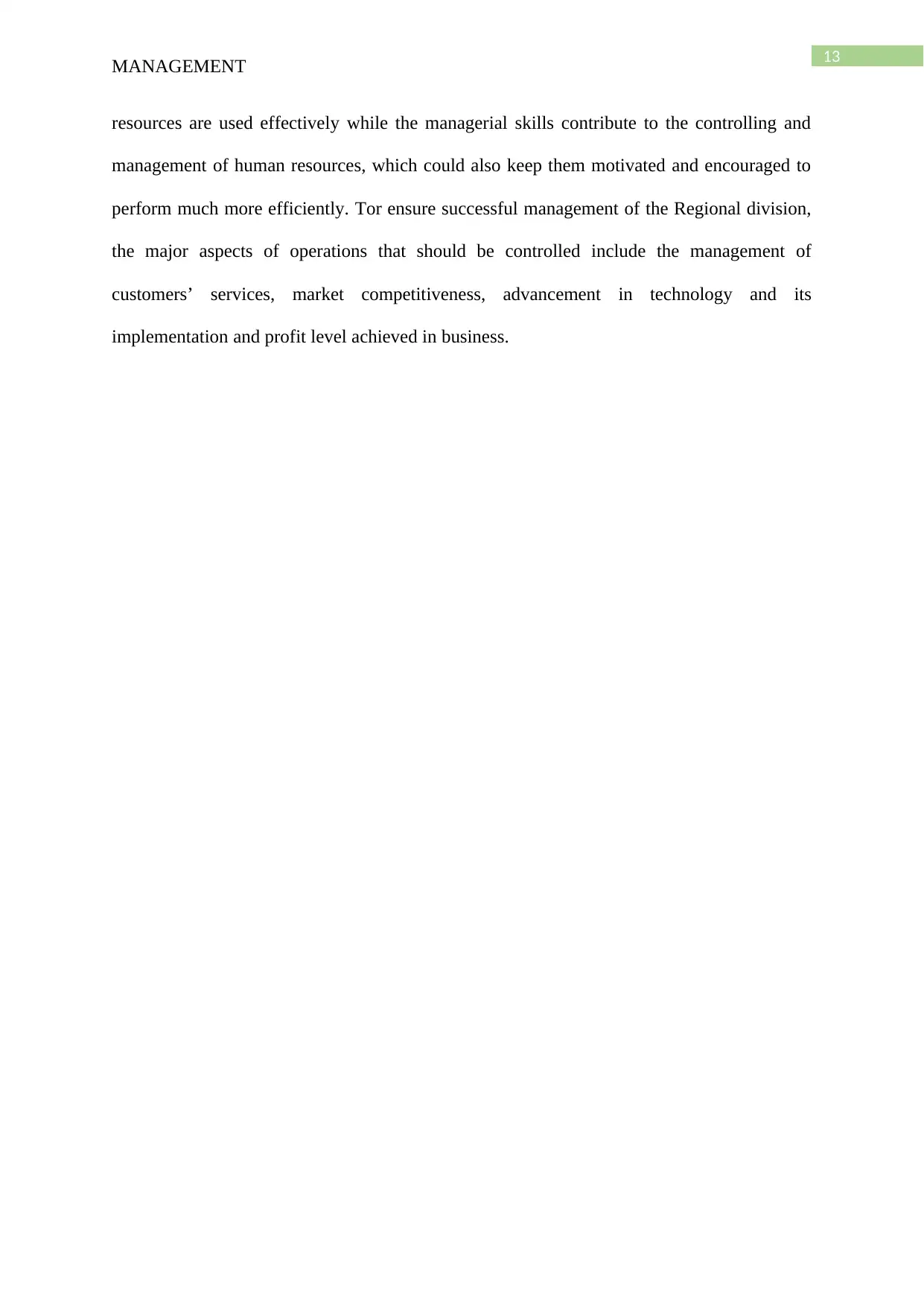
13
MANAGEMENT
resources are used effectively while the managerial skills contribute to the controlling and
management of human resources, which could also keep them motivated and encouraged to
perform much more efficiently. Tor ensure successful management of the Regional division,
the major aspects of operations that should be controlled include the management of
customers’ services, market competitiveness, advancement in technology and its
implementation and profit level achieved in business.
MANAGEMENT
resources are used effectively while the managerial skills contribute to the controlling and
management of human resources, which could also keep them motivated and encouraged to
perform much more efficiently. Tor ensure successful management of the Regional division,
the major aspects of operations that should be controlled include the management of
customers’ services, market competitiveness, advancement in technology and its
implementation and profit level achieved in business.
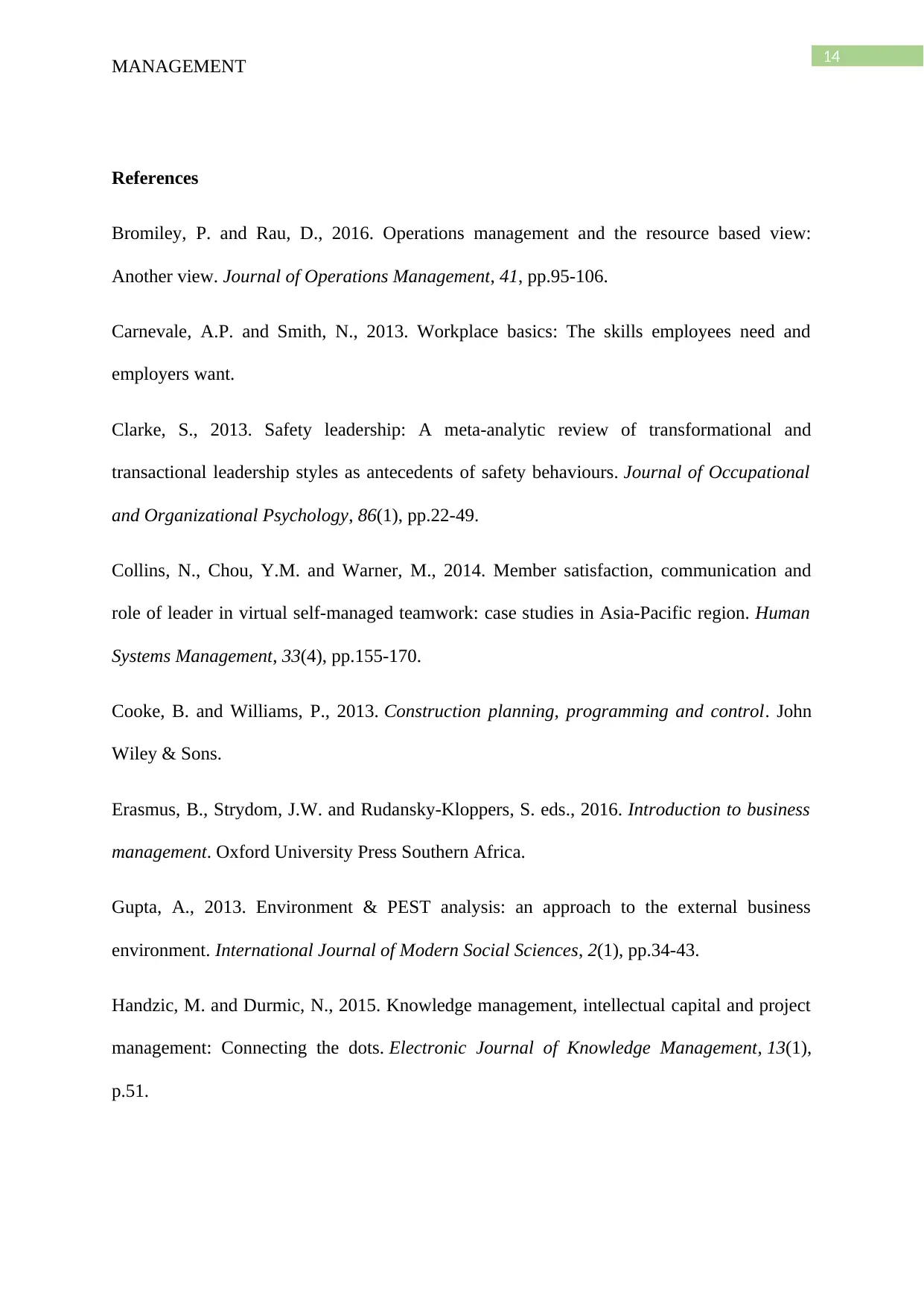
14
MANAGEMENT
References
Bromiley, P. and Rau, D., 2016. Operations management and the resource based view:
Another view. Journal of Operations Management, 41, pp.95-106.
Carnevale, A.P. and Smith, N., 2013. Workplace basics: The skills employees need and
employers want.
Clarke, S., 2013. Safety leadership: A meta‐analytic review of transformational and
transactional leadership styles as antecedents of safety behaviours. Journal of Occupational
and Organizational Psychology, 86(1), pp.22-49.
Collins, N., Chou, Y.M. and Warner, M., 2014. Member satisfaction, communication and
role of leader in virtual self-managed teamwork: case studies in Asia-Pacific region. Human
Systems Management, 33(4), pp.155-170.
Cooke, B. and Williams, P., 2013. Construction planning, programming and control. John
Wiley & Sons.
Erasmus, B., Strydom, J.W. and Rudansky-Kloppers, S. eds., 2016. Introduction to business
management. Oxford University Press Southern Africa.
Gupta, A., 2013. Environment & PEST analysis: an approach to the external business
environment. International Journal of Modern Social Sciences, 2(1), pp.34-43.
Handzic, M. and Durmic, N., 2015. Knowledge management, intellectual capital and project
management: Connecting the dots. Electronic Journal of Knowledge Management, 13(1),
p.51.
MANAGEMENT
References
Bromiley, P. and Rau, D., 2016. Operations management and the resource based view:
Another view. Journal of Operations Management, 41, pp.95-106.
Carnevale, A.P. and Smith, N., 2013. Workplace basics: The skills employees need and
employers want.
Clarke, S., 2013. Safety leadership: A meta‐analytic review of transformational and
transactional leadership styles as antecedents of safety behaviours. Journal of Occupational
and Organizational Psychology, 86(1), pp.22-49.
Collins, N., Chou, Y.M. and Warner, M., 2014. Member satisfaction, communication and
role of leader in virtual self-managed teamwork: case studies in Asia-Pacific region. Human
Systems Management, 33(4), pp.155-170.
Cooke, B. and Williams, P., 2013. Construction planning, programming and control. John
Wiley & Sons.
Erasmus, B., Strydom, J.W. and Rudansky-Kloppers, S. eds., 2016. Introduction to business
management. Oxford University Press Southern Africa.
Gupta, A., 2013. Environment & PEST analysis: an approach to the external business
environment. International Journal of Modern Social Sciences, 2(1), pp.34-43.
Handzic, M. and Durmic, N., 2015. Knowledge management, intellectual capital and project
management: Connecting the dots. Electronic Journal of Knowledge Management, 13(1),
p.51.
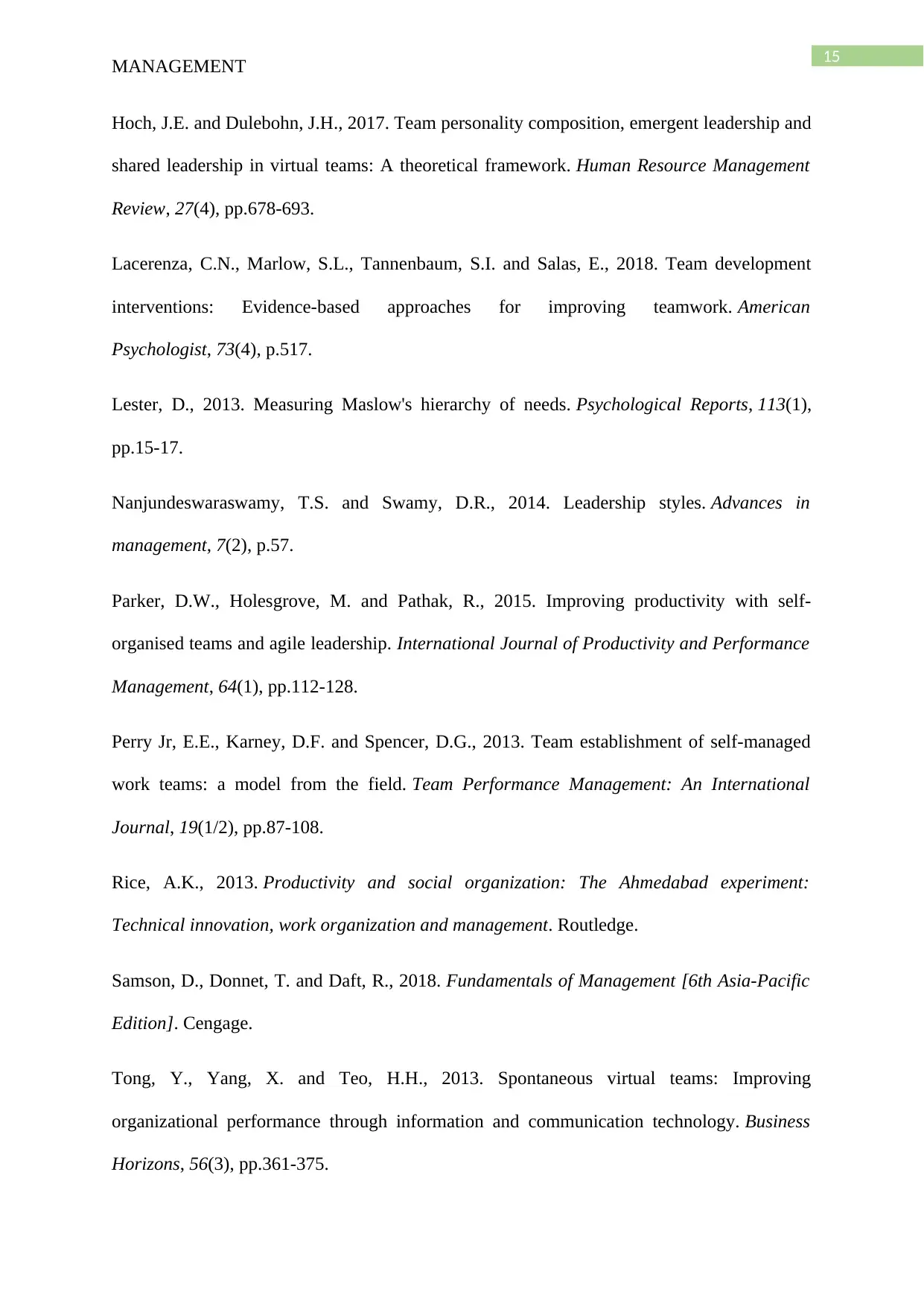
15
MANAGEMENT
Hoch, J.E. and Dulebohn, J.H., 2017. Team personality composition, emergent leadership and
shared leadership in virtual teams: A theoretical framework. Human Resource Management
Review, 27(4), pp.678-693.
Lacerenza, C.N., Marlow, S.L., Tannenbaum, S.I. and Salas, E., 2018. Team development
interventions: Evidence-based approaches for improving teamwork. American
Psychologist, 73(4), p.517.
Lester, D., 2013. Measuring Maslow's hierarchy of needs. Psychological Reports, 113(1),
pp.15-17.
Nanjundeswaraswamy, T.S. and Swamy, D.R., 2014. Leadership styles. Advances in
management, 7(2), p.57.
Parker, D.W., Holesgrove, M. and Pathak, R., 2015. Improving productivity with self-
organised teams and agile leadership. International Journal of Productivity and Performance
Management, 64(1), pp.112-128.
Perry Jr, E.E., Karney, D.F. and Spencer, D.G., 2013. Team establishment of self-managed
work teams: a model from the field. Team Performance Management: An International
Journal, 19(1/2), pp.87-108.
Rice, A.K., 2013. Productivity and social organization: The Ahmedabad experiment:
Technical innovation, work organization and management. Routledge.
Samson, D., Donnet, T. and Daft, R., 2018. Fundamentals of Management [6th Asia-Pacific
Edition]. Cengage.
Tong, Y., Yang, X. and Teo, H.H., 2013. Spontaneous virtual teams: Improving
organizational performance through information and communication technology. Business
Horizons, 56(3), pp.361-375.
MANAGEMENT
Hoch, J.E. and Dulebohn, J.H., 2017. Team personality composition, emergent leadership and
shared leadership in virtual teams: A theoretical framework. Human Resource Management
Review, 27(4), pp.678-693.
Lacerenza, C.N., Marlow, S.L., Tannenbaum, S.I. and Salas, E., 2018. Team development
interventions: Evidence-based approaches for improving teamwork. American
Psychologist, 73(4), p.517.
Lester, D., 2013. Measuring Maslow's hierarchy of needs. Psychological Reports, 113(1),
pp.15-17.
Nanjundeswaraswamy, T.S. and Swamy, D.R., 2014. Leadership styles. Advances in
management, 7(2), p.57.
Parker, D.W., Holesgrove, M. and Pathak, R., 2015. Improving productivity with self-
organised teams and agile leadership. International Journal of Productivity and Performance
Management, 64(1), pp.112-128.
Perry Jr, E.E., Karney, D.F. and Spencer, D.G., 2013. Team establishment of self-managed
work teams: a model from the field. Team Performance Management: An International
Journal, 19(1/2), pp.87-108.
Rice, A.K., 2013. Productivity and social organization: The Ahmedabad experiment:
Technical innovation, work organization and management. Routledge.
Samson, D., Donnet, T. and Daft, R., 2018. Fundamentals of Management [6th Asia-Pacific
Edition]. Cengage.
Tong, Y., Yang, X. and Teo, H.H., 2013. Spontaneous virtual teams: Improving
organizational performance through information and communication technology. Business
Horizons, 56(3), pp.361-375.
Secure Best Marks with AI Grader
Need help grading? Try our AI Grader for instant feedback on your assignments.
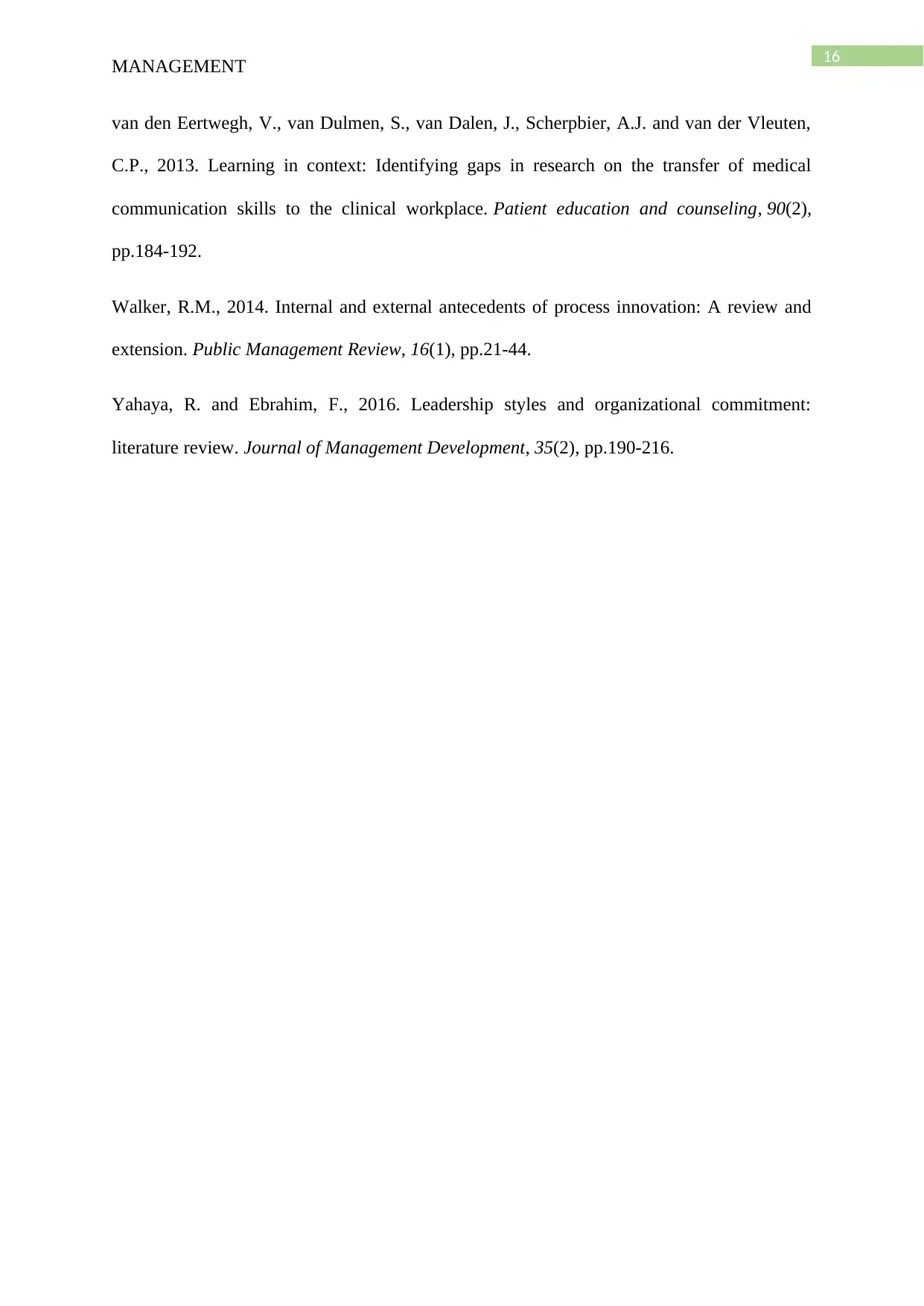
16
MANAGEMENT
van den Eertwegh, V., van Dulmen, S., van Dalen, J., Scherpbier, A.J. and van der Vleuten,
C.P., 2013. Learning in context: Identifying gaps in research on the transfer of medical
communication skills to the clinical workplace. Patient education and counseling, 90(2),
pp.184-192.
Walker, R.M., 2014. Internal and external antecedents of process innovation: A review and
extension. Public Management Review, 16(1), pp.21-44.
Yahaya, R. and Ebrahim, F., 2016. Leadership styles and organizational commitment:
literature review. Journal of Management Development, 35(2), pp.190-216.
MANAGEMENT
van den Eertwegh, V., van Dulmen, S., van Dalen, J., Scherpbier, A.J. and van der Vleuten,
C.P., 2013. Learning in context: Identifying gaps in research on the transfer of medical
communication skills to the clinical workplace. Patient education and counseling, 90(2),
pp.184-192.
Walker, R.M., 2014. Internal and external antecedents of process innovation: A review and
extension. Public Management Review, 16(1), pp.21-44.
Yahaya, R. and Ebrahim, F., 2016. Leadership styles and organizational commitment:
literature review. Journal of Management Development, 35(2), pp.190-216.
1 out of 17
Related Documents
Your All-in-One AI-Powered Toolkit for Academic Success.
+13062052269
info@desklib.com
Available 24*7 on WhatsApp / Email
![[object Object]](/_next/static/media/star-bottom.7253800d.svg)
Unlock your academic potential
© 2024 | Zucol Services PVT LTD | All rights reserved.





